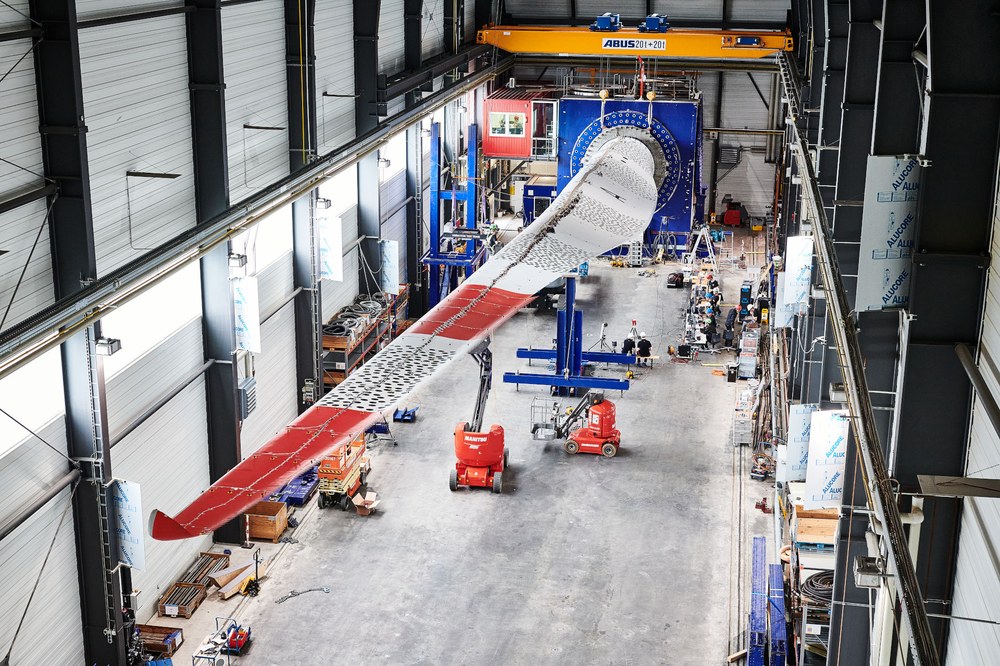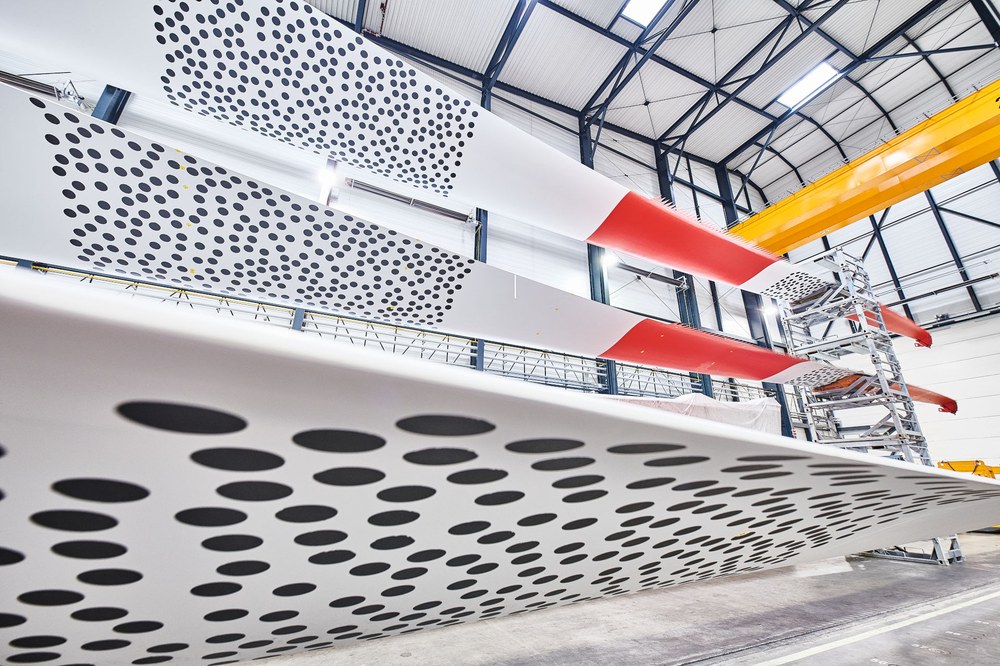Bending and twisting – testing high-tech rotor blades



- Six rotor blades have been equipped with around 1500 sensors for the two wind turbines at DLR's Wind Energy Research Farm.
- These high-tech rotor blades have now been extensively tested by the DLR team at and with the support of Fraunhofer IWES.
- In the process, the researchers were able to acquire a unique wealth of data, which could, for example, be used to programme a digital twin of the rotor blades, which significantly advances modelling and simulation as an important part of wind energy research.
- The aim of the wind energy research conducted by DLR is to make turbines quieter, more durable and more efficient, and to make their operation more sustainable.
- Focus: Energy, digitalisation, wind energy research
With the WiValdi (WindValidation) Wind Energy Research Farm, the German Aerospace Center (Deutsches Zentrum für Luft- und Raumfahrt; DLR) is building a research facility in Krummendeich, Lower Saxony, that is unique in this form. It will enable research into the technological aspects of wind energy – as one of the pillars of the energy system of tomorrow – on a real scale. The two wind turbines at the research farm have special rotor blades manufactured for this purpose. The company Enercon equipped them with around 1500 sensors during production. The researchers want to use the rotor blades to investigate how wind turbines can be designed to be quieter, more durable and efficient, and how they can be operated more sustainably.
Comprehensive tests provide unique treasure trove of data
In the summer of 2022, before the rotor blades were assembled at DLR’s research farm, they made a stopover in Bremerhaven. At the Fraunhofer Institute for Wind Energy Systems (IWES), all six blades were subjected to comprehensive structural dynamic tests. During these intensive trials, the team from the DLR Institute of Aeroelasticity and the DLR Institute of Lightweight Systems, with the support of IWES, was able to determine important properties of the rotor blades and obtain a wealth of data that is unique worldwide. The data allow for very precise statements to be made about the behaviour of the blades and help to confirm and further develop simulations. In addition, the researchers can build a ‘digital twin’ of the rotor blades. This helps research and industry to develop new standards and improve blade production. "With these tests, we have laid the foundation for future research with the rotor blades on site in Krummendeich," describes Yves Govers from the DLR Institute of Aeroelasticity and leader of the instrumentation work package.
Spotlight on vibration and load behaviour
For the tests, the team suspended the rotor blades, one after the other, each weighing around 20 tonnes with a length of 57 metres, on a crane with elastic ropes. 500 ropes, similar to those used in bungee jumping, were attached to the blade tip and the blade root. The blades were then subjected to vibrations with a special vibrating device or with hammer blows. This special suspension allowed the researchers to determine the vibration frequency of the blade without the influence of environmental conditions.
At the same time, they used the experiment to set up and test the approximately 1500 sensors already installed on and in the blades during production. In addition, they added and measured further measurement points and sensors along the entire blade specifically for these trials. "You have to be very careful when installing, documenting and testing, otherwise the measurements will not be correct. Consequently, we were busy for a while with six blades and needed an average of three days per rotor blade for assembly, testing and dismantling," explains Govers. In a second type of test, the researchers mounted one of the identical blades on a test rig and subjected it to a pulling test to measure statics, deformation and internal stresses.
Longer and lighter rotor blades – technical challenge to increase efficiency
In modern wind turbines, the blades are becoming progressively longer and, at the same time, lighter thanks to new types of materials. This means that the turbines can be operated more efficiently and locations that are less wind-intensive can also be used. However, this also brings new technical challenges: "The blades never really stand still but are always in motion – whether due to air movement or even the smallest vibrations in the subsurface, referred to as microseisms."
"For efficient, quiet and safe operation, you therefore need to know the deformation behaviour of the rotor blades well. A blade bends, but also twists in the process. The degree of this twisting is especially important to increase efficiency," explains Govers. "But we also look at the load on the rotor blades. To do this, we have installed special sensors over several blade sections. This allows us to evaluate the load over the entire length of the blade due to the incident flow during operation. Further sensors are used for early detection of damage. With this comprehensive instrumentation, we hope to gain completely new insights into blade deformation and blade loading."
Researchers from all over Europe are already contacting the DLR team and showing interest in the work. "I don't know of anything comparable," Govers sums up. "The turbine is probably the most comprehensively sensor-equipped wind turbine in the world and will be unparalleled for years to come." The six high-tech rotor blades will make their way to the DLR Wind Energy Research Farm in Krummendeich in autumn 2022 and will then be assembled there.
DLR will provide an insight into this research work and the development of the DLR Wind Energy Research Farm WiValdi at the WindEnergy Hamburg trade fair from 27 to 30 September 2022 in Hall B6 Stand 464.
